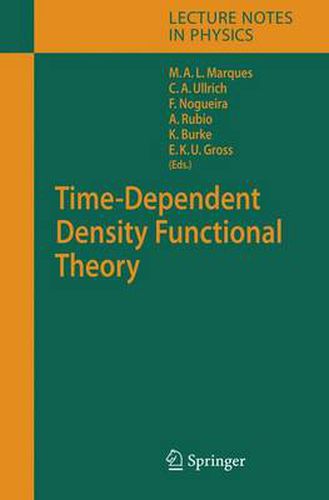Readings Newsletter
Become a Readings Member to make your shopping experience even easier.
Sign in or sign up for free!
You’re not far away from qualifying for FREE standard shipping within Australia
You’ve qualified for FREE standard shipping within Australia
The cart is loading…






This title is printed to order. This book may have been self-published. If so, we cannot guarantee the quality of the content. In the main most books will have gone through the editing process however some may not. We therefore suggest that you be aware of this before ordering this book. If in doubt check either the author or publisher’s details as we are unable to accept any returns unless they are faulty. Please contact us if you have any questions.
The year 2004 was a remarkable one for the growing ?eld of time-dependent density functional theory (TDDFT). Not only did we celebrate the 40th - niversary of the Hohenberg-Kohn paper, which had laid the foundation for ground-state density functional theory (DFT), but it was also the 20th - niversary of the work by Runge and Gross, establishing a ?rm footing for the time-dependent theory. Because the ?eld has grown to such prominence, and has spread to so many areas of science (from materials to biochemistry), we feel that a volume dedicated to TDDFT is most timely. TDDFT is based on a set of ideas and theorems quite distinct from those governingground-stateDFT,butemployingsimilar techniques.Itisfarmore than just applying ground-state DFT to time-dependent problems, as it - volves its own exact theorems and new and di?erent density functionals. Presently,themostpopularapplicationistheextractionofelectronicexcit- state properties, especially transition frequencies. By applying TDDFT after thegroundstateofamoleculehasbeenfound,wecanexploreandunderstand the complexity of its spectrum, thus providing much more information about the species. TDDFT has a especially strong impact in the photochemistry of biological molecules, where the molecules are too large to be handled by t- ditional quantum chemical methods, and are too complex to be understood with simple empirical frontier orbital theory.
$9.00 standard shipping within Australia
FREE standard shipping within Australia for orders over $100.00
Express & International shipping calculated at checkout
This title is printed to order. This book may have been self-published. If so, we cannot guarantee the quality of the content. In the main most books will have gone through the editing process however some may not. We therefore suggest that you be aware of this before ordering this book. If in doubt check either the author or publisher’s details as we are unable to accept any returns unless they are faulty. Please contact us if you have any questions.
The year 2004 was a remarkable one for the growing ?eld of time-dependent density functional theory (TDDFT). Not only did we celebrate the 40th - niversary of the Hohenberg-Kohn paper, which had laid the foundation for ground-state density functional theory (DFT), but it was also the 20th - niversary of the work by Runge and Gross, establishing a ?rm footing for the time-dependent theory. Because the ?eld has grown to such prominence, and has spread to so many areas of science (from materials to biochemistry), we feel that a volume dedicated to TDDFT is most timely. TDDFT is based on a set of ideas and theorems quite distinct from those governingground-stateDFT,butemployingsimilar techniques.Itisfarmore than just applying ground-state DFT to time-dependent problems, as it - volves its own exact theorems and new and di?erent density functionals. Presently,themostpopularapplicationistheextractionofelectronicexcit- state properties, especially transition frequencies. By applying TDDFT after thegroundstateofamoleculehasbeenfound,wecanexploreandunderstand the complexity of its spectrum, thus providing much more information about the species. TDDFT has a especially strong impact in the photochemistry of biological molecules, where the molecules are too large to be handled by t- ditional quantum chemical methods, and are too complex to be understood with simple empirical frontier orbital theory.